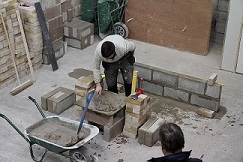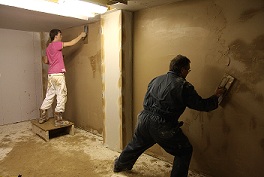Bricklaying can prove to be an invaluable skill to gain, whether you're looking to start a new career or simply to carry out your own work at home. Professional bricklayers are always in demand, as are multi-skilled tradespeople, which is why the courses we offer in this area are some of the most popular amongst our prospective candidates.
Whatever your skill level or end goal, we can match you to the course that's right for you, whether you're looking to undertake paid work or simply gain an understanding of how you can improve your home and garden without hiring a labourer.
If you're unsure about which of our courses is right for you, here are some guidelines to help you make your decision:
If you're looking to carry out work at home:
For complete beginners who want to learn bricklaying skills from scratch, our
DIY Bricklaying Course provides the best possible introduction to the skill. Whilst equipping you with the correct skills and knowledge to undertake and oversee projects at home, it also provides a good foundation from which to branch out into other DIY and home improvement areas, such as plastering and tiling.
If you want to target specific areas and learn essential skills:
Whether you're a beginner or an experienced bricklayer who needs to update their skills, our
Essential Bricklaying course can help you to identify and target your areas of interest. From mastering different bonds to inserting windows and lintels, this course will provide you with the practical knowledge to deal with a number of common brickwork jobs. Although this course is open to experienced bricklayers who are in need of retraining, those with little to no experience find that this course is more accessible than our more advanced options.
If you're looking to become a professional:
If you're looking to start a brand new career and require a thorough understanding of bricklaying, then our
Professional Bricklaying course is the option for you. With state of the art facilities and some of the best success rates in the country, our academies are the perfect place to gain both practical experience and a through knowledge of bricklaying, in order to undertake paid work or progress to further qualifications.
To browse our full range of bricklaying courses
click here, or
get in touch with us today if you are in need of further guidance.
Bricklaying and plastering are two of the most common trades that come up in discussion about the skills shortage the construction industry is suffering from, but the latest State of Trade survey suggests this shortage is more dire than many may have thought - especially when it comes to small businesses.
 The survey, set up by the Federation of Master Builders, found that more than a third of construction SMEs are struggling to recruit the required number of bricklayers to keep up with their workload. In additional to this, 27% of firms are also having difficulty finding the plasterers they need.
The survey, set up by the Federation of Master Builders, found that more than a third of construction SMEs are struggling to recruit the required number of bricklayers to keep up with their workload. In additional to this, 27% of firms are also having difficulty finding the plasterers they need.
FMB Chief Executive Brian Berry said: "The results act as a stark warning that the government must not take the recovery in the construction sector for granted. Although this snapshot of small construction firms marks the fifth consecutive quarter of positive results, if we don’t have enough of the right people to complete the work, private and public projects could be stalled across the board."
With the skilled labourers demand rising in tandem with the demand for new building work, stalling projects really is becoming a major concern. The construction industry is relying on new people to earn their qualifications and join the workforce - people like you. Are you tired of your desk-based job, seek out a more physical and hands-on career or simpy want a more practical alternative to going to university? A construction career could be exactly what you're looking and for and after reading this, you know you'll be welcomed with open arms. Combine that with a varied worklife and impressive wage and you've got a pretty fantastic career ahead of you.
The quickest and most effective way to becoming a qualified plasterer or bricklayer is through an intensive training course from Access Training. In matter of weeks we can have you fully trained to a professional standard, complete with official City & Guilds qualifications. You'll be taught in a state-of-the-art centre by experienced tradespeople, who will be sharing their trade experiences as well as delivering the skills you need. And we don't just offer bricklaying and plastering either - we also have plumbing, electric, gas, carpentry, tiling and decorating courses ready and available!
Just give our team a call on 0800 345 7492 a course adviser will be in touch to discuss the options most suitable to you. Starting a brand new career has never been easier!
News via Construction Enquirer
With a distinct shortage of skilled bricklayers during a big construction boom, naturally the wages are just as high as the demand. But only this month has it been revealed just how high these wages can go, as some bricklayers are found to be earning six-figure salaries in certain parts of the UK.
 Speaking to the Sun newspaper, property consultant Mark Famer explained that because of the shortage builders could command such high salaries. In London he said day rates are anywhere between £150 and £200, with more experienced bricklayers able to "earn the equivalent of £100,000 a year". This is quite a turn from the time during the recession, where rates fell by 50% due to the lack of work.
Speaking to the Sun newspaper, property consultant Mark Famer explained that because of the shortage builders could command such high salaries. In London he said day rates are anywhere between £150 and £200, with more experienced bricklayers able to "earn the equivalent of £100,000 a year". This is quite a turn from the time during the recession, where rates fell by 50% due to the lack of work.
While London might be the centre of attention in all of this, that doesn't mean the same wage rises don't apply elsewhere! There are new build projects starting across the UK, especially in the housing sector thanks to Government plans to build over 200,000 new homes. These houses are going to not only need bricklayers, but also qualified carpenters, plasterers. tilers and decorators to get the job finished - all of which are currently in demand by the industry.
But before you can take advantage of the demand and start a brand new career in the construction industry, you'll need to earn the qualifications employers look for. At Access Training, we make sure that our trades training courses give you exactly what you need for a long and successful career - not just in terms of qualifications, but also skills that will remain with you for the rest of your life. No matter which path you plan to take, Access specialises in all the different trade types to ensure you get the best possible training.
Want to find out more? Give our course advise team a call on 0800 345 7492. They'll be happy to answer any questions you may have, and you can also arrange a tour of our training centre to find out first hand how we do things here. And who knows, maybe you'll be earning that six figure salary one day!
Via International Business Times
 Even though we're only one month into it, 2014 is setting up to be a fantastic year for the construction industry and tradespeople alike with a seemingly constant stream of news to suggest Britain is truly climbing out of the recession and the industry has a long line of prosperity ahead of it. This doesn't look like it'll just mean more jobs in the industry for trainees currently going through various construction training courses, but improved benefits for you as well.
Even though we're only one month into it, 2014 is setting up to be a fantastic year for the construction industry and tradespeople alike with a seemingly constant stream of news to suggest Britain is truly climbing out of the recession and the industry has a long line of prosperity ahead of it. This doesn't look like it'll just mean more jobs in the industry for trainees currently going through various construction training courses, but improved benefits for you as well.
Reed, one of the largest recruitment companies in the UK, revealed that new vacancies on its website rose by 29% in January compared to 2013 - with construction and property leading the way with a 74% increase. This is due to the construction boom the industry is currently in the midst of, along with a significant rise in both private and public housing planned. Reed's statistics showed that around one in five of the national workforce actively searched for a new job in January.
However despite the gradual increase in job vacancies there have been over the last few months, the average salary hasn't seen much change at all. This is set to change though as a skills shortage, particularly in the construction industry, has become prevalent. Many fear that there is simply not enough trained labourers to replace those that will be retiring in the next five or so years - and so fully qualified plasterers, carpenters, tilers and bricklayers in high demand. Knowing that there's a construction boom currently taking place, workers have also gained newfound confidence in their careers. And of course, the ever-growing cost of living is also a factor in why employers are being pressured to (deservedly) increase pay.
So what does this mean for new construction trainees? Well, for starters there's never been a better time to start a career in the construction trade, whichever sector you think may be suitable for you! Qualified construction workers have always been in demand and commanded impressive salaries, but the industry really is at the top of its game right now - not only will you find yourself in an exciting and varied line of work, but your skills will be valued more than ever.
But what's the quickest and most effective way to break into the industry? College courses can be beneficial, but not only are many understaffed with limited facilities but they can also take years to complete. While the industry is expected to enjoy this "golden age" for a fair few years, there's no guarantee that the high demand for workers will last this long. What you need is an intensive trades training course - the very kind we provide here at Access Training Academies. Our training courses last a matter of weeks rather than months, and pack the same (if not better!) quality you'd find elsewhere. In smaller class sizes you'll learn from tutors with a number of years' experience in their field, completing both theory and practical work before earning valued qualifications here at our accredited Cardiff training centre. These qualifications come from awarding bodies such as City & Guilds, and represent exactly what a plasterer, carpenter, tiler or bricklayer need to break into the industry successfully.
To find out more about the construction training courses we offer, call Access on 0800 345 7492 and speak to one of our course advice team. They'll be happy to answer any questions you have and arrange a full tour of our facilities so you can see exactly what we do before signing up.
2014 is a brand new year - take hold of it and take the steps toward that new career you've always dreamed of.
Now might just be the perfect time to make that career change and begin your construction training! Following on from the predictions that the construction industry will see a boom over the next four years, new survey results for quarter 3 2013 have found that the trade's recovery is well on the way.
The construction trade survey, compiled by the Construction Products Association using data from the Civil Engineering Contractors Association, Construction Products Association, Federation of Master Builders, National Federation of Builders, National Specialist Contractors Council and the UK Contractors Group, found that activity rose for the second consecutive quarter. This growth came from across all areas of the industry with even more anticipated in the next 12 months.
After five years of difficult conditions for the construction industry, optimism is now rising as building contractors were reported to be the most positive since pre-recession 2007. 30% of specialist contactors reported that enquiries for new work rose this quarter, as well as 30% of civil engineering firms reporting a rise in order books.
However despite this it isn't all good news just yet. Rising costs are becoming a key issue, with manufacturers reporting that costs have risen over the last year. As well as citing wages as the key factor, the rising price of fuel, energy and raw materials are also responsible.
 There are two trades in particular that have had recruitment trouble - both of which we offer courses for here at Access. 34% of of firms reported difficulty recruiting bricklayers, while 32% also had a problem with plasterers. Both of these are the highest levels of difficulty reported since 2008, so those who may be considering plastering training or bricklaying courses have a clear gap in the market ahead of them. You can read more about the plastering and bricklaying courses we offer on the website.
There are two trades in particular that have had recruitment trouble - both of which we offer courses for here at Access. 34% of of firms reported difficulty recruiting bricklayers, while 32% also had a problem with plasterers. Both of these are the highest levels of difficulty reported since 2008, so those who may be considering plastering training or bricklaying courses have a clear gap in the market ahead of them. You can read more about the plastering and bricklaying courses we offer on the website.
Other key findings of the quarter three survey were:
- 43% of building contractors, on balance, stated that activity rose in Q3, the second highest balance since 2007
- Private new housing was the key driver of construction growth in Q3 with 22% of contractors, on balance, reporting that activity rose in Q3 compared with a year ago
- Building contractor new orders reached their highest level since 2007
- The most positive sector for new orders was public non-housing, which primarily covers education and health, with a balance of 9%
- 49% of building contractors reported that costs rose in Q3, with labour costs and materials costs both contributing to the rise
- A balance of 4% of building contractors reported that tender prices rose in Q3; however, with costs also rising, a balance of 11% reported that profit margins had continued to fall.
More information can be found via The Construction Index
---
If you would like to find out more about the construction training courses we offer here at Access, which including carpentry, tiling and painting & decorating as well as the aforementioned brickwork and plastering, please get in contact with us on 0800345 7492 and our course advisers will be happy to tell you more. With a variety of flexible courses that will give you the necessary construction qualifications, Access Training is the best method to get the required skills fast without skimping on any of the quality.
(Part 1 of this article can be viewed HERE)
Now that we know what causes brickwork to need re-pointing and how to prepare for it, it's time to look at the procedure itself for getting your brickwork back up to scratch!
POINTING PROCEDURE
You will require a hawk to carry the mortar, a pointing trowel and a soft brush
- Always start at the top of the walling to be pointed and work downwards to prevent dropped mortar marking the cleaned brickwork below.
- Make sure the joints are clear of any loose old mortar.
- Load the hawk with mortar flattened to about a 10mm thickness.
- Using your pointing trowel, pick up small amounts of mortar from the hawk and press firmly into the “perp” joints, (these are the vertical joints). Carefully fill each perp joint using a second filling if necessary.
- After filling the perp joints start on the bed joints (these are the horizontal joints)
- Carefully fill each bed joint with a second application if required.
- After completing an area of approximately one square meter, finish the mortar off with a pointing trowel. **
- Apply the mortar filling to the rest of the wall.
- When sufficiently dry, brush off with a fine brush to remove any excess mortar.
** At this stage there are a number of different finishes you could apply, however they require in-depth tutorial that can't be provided from this blog alone. If you would like to find out more, give Access Training a call on 0800 345 7492 for information on our range of bricklaying and construction courses for DIY enthusiasts and professionals alike.
- Richard James
The most common part of a building that usually requires new pointing after it’s been built is the chimney stack. Due to the adverse conditions put upon it, it’s not surprising that it requires re- pointing. Usually you will find that the old cement/mortar will come out fairly easy. A cavity wall tie is often used for this process when the bricks are hard, as no damage will occur to the arris (edge) of the brick. If the bricks are of a soft nature you could use a piece of wood cut down to the width of the joint. Failing this you could use a “plugging chisel” which is a tapered chisel and can be purchased from most building supplies.
PROCEDURE
Take out all the mortar/cement to a depth of no more than 15mm, ensuring you are wearing the appropriate P.P.E. (safety glasses. dust mask etc.) After all the mortar/cement has been taken out brush all the joints to make sure any loose material is removed. This also make sure the arrises are clean. Do not use a wire brush as this will damage the brick. Wash down the wall with clean water - stubborn patches or stains can be removed using a scrubbing brush. Allow the wall to dry out, if you don’t it will become difficult to point the wall and the bricks may get soiled with the mortar. Also the more water there is in the wall, the more shrinkage movement there may be when the wall dries out. If this happens (moisture trapped in the joints), the first sign of frost the moisture will freeze and will expand and the wall gets damaged.
MORTARS FOR POINTING
If the area to be pointed is built with hard bricks in exposed places, a mix of 2:1 is preferred. This is two parts sand to one part cement, not mixed to wet. For general brickwork a mix of 3:1 is preferred.
In Part 2 I will explain the procedure to carry out the pointing sequence.
- Richard James
If you would like to learn more about bricklaying or any of aspect of the construction trade, Access Training offer a wide variety of construction courses to both beginners and existing tradesmen in need of new/updated qualifications. If you would like to find out more upon what's on offer, give us a call on 0800 345 7492 and arrange a visit of our accredited training centre.